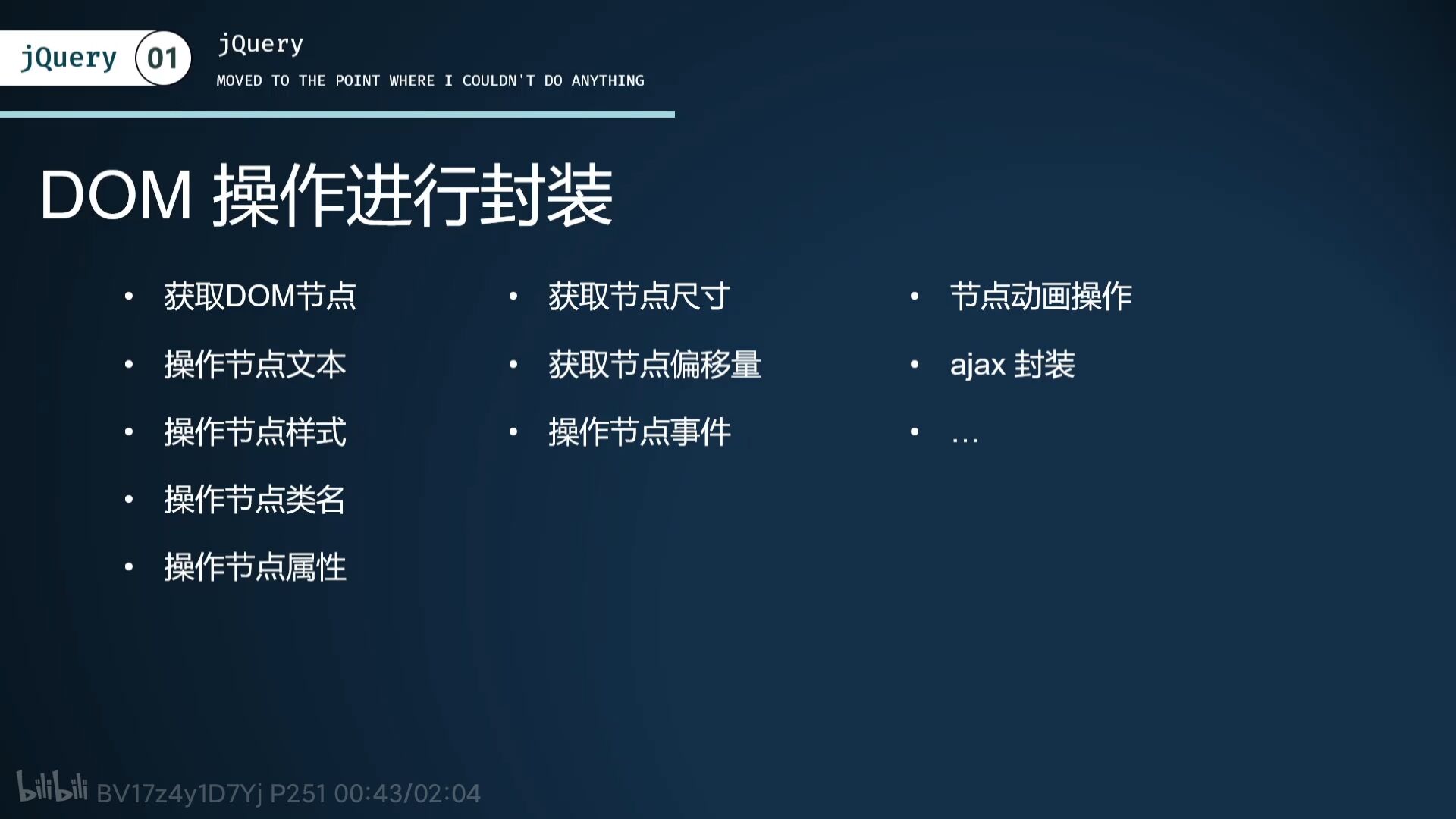【千锋】H5大前端-学习打卡06(Ajax 与 jQuery)
【前后端交互】
前端JS无法和数据库进行操作,但可以通过服务器沟通数据库和客户端。
前端由前端工程师负责,服务器由后端工程师负责。
【接口文档】
后端开发人员写好服务器后,需要给前端人员的接口文档。
前端按照接口文档的规范,就可以拿到后端数据了。
【第一次测试Ajax】
Ajax是众多请求方式的一种。
标准Ajax步骤:
1 | // 1. 创建Ajax对象 |
- 配置请求信息:
- 请求方式:按照接口文档,
GET或POST,大小写都行 - 请求地址:基准地址+相对地址
- 是否异步:true是异步请求,false是同步请求
- 请求方式:按照接口文档,
如何拿到后端返回的信息呢?
在xhr对象内有个成员叫做xhr.resposeText,表示后端给我们的信息
1 | // 1. 创建Ajax对象 |
【第二次测试Ajax】
很多时候后端返回给前端的不是普通字符串,而是json格式的字符串(数据类型)
1 | // 1. 创建Ajax对象 |
当后端返回json格式字符串的时候,我们需要单独解析。
解析语法:JSON.parse(json格式字符串)
返回值:是解析好的js格式的数据
1 | // 3. 配置请求完成的事件(会在本次请求完成之后触发) |
解析好后会发现拿到一个对象数据类型,里面是后端返回的信息
【请求方式】
| GET | POST |
|---|---|
| 偏向获取的语义化 | 偏向提交的语义化 |
| 参数是查询字符串 | 参数格式多样,但需要特殊说明 |
| 大小限制在 2KB 左右 | 理论上没有限制 |
| 参数位置在地址后面 直接书写查询字符串格式 |
参数位置在请求体内 也就是 xhr.send()后面的小括号里 |
【GET和POST请求】
示例:GET请求
1 | // GET请求 |
示例:POST请求
1 | // POST请求 |
【案例-登录】
- 【分析需求】:
- 什么时候发送请求?
=> 点击登录按钮的时候
=> 需要给 form 标签绑定一个表单提交时间 - 需要拿到哪些信息?
=> 拿到用户填写的用户名和密码 - 需要如何发送给后端?
=> 按照接口文档的规范进行发送 - 请求完成以后我们需要做什么?
=> 根据后端返回的信息,进行一些后续的操作
=> 如果后端返回的信息是登陆成功,进行页面跳转
=> 如果后端返回的信息是登陆失败,提示用户错误
- 什么时候发送请求?
1 |
|
【引入jQuery】
一个大型的、简单的第三方类库
就是把常用的操作封装在一起,用的时候直接使用就行了。
jQuery对DOM操作进行了完善的封装,常见的DOM操作封装到了一起,包括各种元素操作以及rejects操作。
【jQuery在线引用地址】
- 官网jquery压缩版引用地址:
- 3.1.1版本:
<script src="https://code.jquery.com/jquery-3.1.1.min.js"></script>- 3.0.0版本:
<script src="https://code.jquery.com/jquery-3.0.0.min.js"></script>- 2.1.4版本:
<script src="http://code.jquery.com/jquery-2.1.4.min.js"></script>- 百度压缩版引用地址:
<script src="http://libs.baidu.com/jquery/2.1.4/jquery.min.js"></script>- 微软压缩版引用地址:
<script src="http://ajax.aspnetcdn.com/ajax/jquery/jquery-2.1.4.min.js"></script>
当引入jQuery文件后,会在全局暴露两个变量名,打印时显示出的内容是一样的。
$jQuery
【获取DOM节点】
》 jQuery的选择器
语法:$('选择器')
不管使用任何选择器,获取到的元素都是一个元素集合。
1 | // id选择器 |
》 jQuery的筛选器
语法:$('选择器').筛选器名称()
对选择器获取到的元素进行二次筛选
1 | // first() |
【操作DOM节点】
》 jQuery操作文本内容
html()等价于原生JS中的innerHTML1
2
3
4
5
6
7
8
9
10
11
12
13
14
15
16<div>
hello
<p>你好 世界</p>
world
</div>
<script>
// 1. html() 获取
console.log($('div').html())
// 2. html() 设置
// 语法:元素集合.html(你要设置的内容)
$('div').html('我是后来设置的内容')
// 注意:可以识别并解析HTML结构字符串
// $('div').html('<h2>我是后来设置的内容</h2>')
</script>text()等价于原生JS中的innerText方法1
2
3
4
5
6
7
8
9
10
11
12
13
14
15<div>
hello
<p>你好 世界</p>
world
</div>
<script>
// 1. text() 获取
console.log($('div').text())
// 2. text() 设置
// 语法:元素集合.text(你要设置的内容)
$('div').text('我是后来设置的内容')
// 注意:不可以识别并解析HTML结构字符串
</script>val()等价于原生JS中的value属性1
2
3
4
5
6
7
8
9
10
11<input type="text" value="hello world">
<script>
// 1. val() 获取
console.log($('input').val())
// 2. text() 设置
// 语法:元素集合.val(你要设置的内容)
// 作用:用来设置该表单元素的value值
$('input').val('我是后来设置的内容')
</script>
》 jQuery操作元素类名
addClass()等价于原生JS中的value属性1
2
3
4
5
6<div class="a b c d"></div>
<script>
// 语法:元素集合.addClass(需要添加的类名)
$('div').addClass('e')
</script>removeClass()等价于原生JS中的value属性1
2
3
4
5
6<div class="a b c d"></div>
<script>
// 语法:元素集合.addClass(需要删除的类名)
$('div').addClass('b')
</script>toggleClass()等价于原生JS中的value属性1
2
3
4
5
6
7
8
9
10
11
12<div class="a b c d"></div>
<button>切换</button>
<script>
// 语法:元素集合.addClass(你要切换的类名)
// 如果本身有这个类名,就删除;若没有这个类名,就添加
var btn = document.querySelector('button')
button.onclick = function () {
// 执行jQuery切换div类名的操作
$('div').toggleClass('box')
}
</script>
》 jQuery操作元素样式
css()方法1
2
3
4
5
6
7
8
9
10
11
12
13
14
15
16
17
18
19
20
21
22
23
24
25
26
27
28
29
30
31
32
33
34<style>
div {
height: 200px;
background-color: skyblue;
}
</style>
<div style="width: 100px;"></div>
<script>
// 1. css() 获取样式
// 语法:元素集合.css(你要获取的样式名称)
// 可以获取到元素的行内样式,也可以获取到元素的非行内样式
console.log($('div').css('width'))
console.log($('div').css('height'))
// 2. css() 获取样式
// 语法:元素集合.css(样式名, 样式值)
// 当设置的元素的样式值单位是px的时候,可以省略不写
console.log($('div').css('width', '300px'))
console.log($('div').css('height', 500))
console.log($('div').css('background-color', 'red'))
// 3. css() 批量设置样式
// 语法:元素集合.css({ 你所有设置的样式 })
// 写在一个用花括号{}包裹的对象里
$('div').css({
width: 200,
height: 320,
opacity: 0.68,
'background-color': 'purple'
})
</script>
》 jQuery操作元素属性
attr()方法1
2
3
4
5
6
7
8
9
10
11
12
13
14
15
16
17
18<div id="box" hello="world">我是一个 div 标签</div>
<script>
// attr()
// 作用:设置和获取元素的属性,一般用于操作元素的自定义属性
// 注意:attr()操作的所有属性都会直接出现在元素的标签上
// attr() 获取
// 语法:元素.attr(你要获取的属性名)
// 返回值:该属性名对应的属性值
console.log($('div').attr('hello'))
console.log($('div').attr('id'))
// attr() 设置
// 语法:元素.attr(属性名, 属性值)
console.log($('div').attr('a', 100))
console.log($('div').attr('id', 'container'))
</script>removeAttr()方法1
2
3
4
5
6
7
8
9
10<div id="box" hello="world">我是一个 div 标签</div>
<script>
// removeAttr()
// 作用:对元素的属性值进行删除操作
// 语法:元素集合.removeAttr(你要删除的属性名)
$('div').removeAttr('hello')
$('div').removeAttr('id')
</script>prop()方法1
2
3
4
5
6
7
8
9
10
11
12
13
14
15
16
17
18
19<div id="box" hello="world">我是一个 div 标签</div>
<script>
// prop()
// => 当prop()设置元素的原生属性,会直接响应在元素标签上
// => 当prop()设置元素自定义属性,不会直接响应在元素标签上,会响应在元素对象身上
// 注意:prop()方法不能获取元素标签身上的自定义属性,只能获取到prop()自己设置的自定义属性
// prop() 设置
// 语法:元素集合.prop(属性名, 属性值)
$('div').prop('id', 'container')
$('div').prop('a', 100)
// prop() 获取
// 语法:元素集合.prop(属性名, 属性值)
console.log($('div').prop('id'))
console.log($('div').prop('hello')) //拿不到该自定义属性,因为不是prop自己设置的
console.log($('div').prop('a')) //可以拿到该自定义属性,是prop刚刚自己设置的
</script>removeProp()方法1
2
3
4
5
6
7
8
9
10
11
12<div id="box" hello="world">我是一个 div 标签</div>
<script>
// removeProp()
// 作用:对元素的属性值进行删除操作
// 注意:不能删除原生属性,只能删除由prop自定义的属性
// 语法:元素集合.removeProp(你要删除的属性名)
$('div').removeProp('id') //无法删除,因为是原生属性
$('div').prop('a', 100)
$('div').removeProp('a') //可以删除
</script>
【jQuery获取元素尺寸】
- 内容区域
width()height()
- 内容+padding
innerWidth()innerHeight()
- 内容+padding+border
outerWidth()outerHeight()
- 拿到的包含你设置的margin值
outerWidth(true)outerHeight(true)
- 不管元素是否隐藏,都能拿到值
- 不管盒子模型是什么状态,拿到的尺寸区域不变
【jQuery获取元素偏移量】
offset1
2
3// 获取元素相对于页面左上角的位置
// 注意:返回值是一个对象数据类型{ top: yyy, left: xxx}
console.log($('div').offset())position1
2
3// 获取元素的定位位置
// 注意:如果设置的是 right 和 bottom,会自动帮你算成 left 和 top 的值
console.log($('span').position())
【jQuery绑定事件】
on()方法绑定事件1
2
3
4
5
6
7
8
9
10
11
12
13
14
15
16
17// 1. 基础绑定事件
// 语法:元素集合.on('事件类型', 事件处理函数)
$('div').on('click', function () {console.log('我是 div 的点击事件') })
// 2. 事件委托绑定事件
// 语法:元素集合.on('事件类型', 选择器, 事件处理函数)
$('div').on('click', 'p', function () {console.log('我是事件委托形式的点击事件') })
// 把事件绑定给 div 元素,当你在 div 内容的 p 元素触发事件的时候,会执行事件处理函数
// 3. 批量绑定事件
// 语法:元素集合.on({事件类型1: 处理函数, 事件类型2: 处理函数 })
// 注意:不能进行事件委托
$('div').on({
click: function () {console.log('我是 div 的点击事件') }
mouseover: function () {console.log('鼠标移入事件') }
mouseout: function () {console.log('鼠标移出事件') }
)one()方法绑定事件(和on()一样,但只能执行一次)1
2
3
4
5
6
7
8
9
10
11
12
13
14
15
16
17// 1. 基础绑定事件
// 语法:元素集合.on('事件类型', 事件处理函数)
$('div').one('click', function () {console.log('我是 div 的点击事件') })
// 2. 事件委托绑定事件
// 语法:元素集合.on('事件类型', 选择器, 事件处理函数)
$('div').one('click', 'p', function () {console.log('我是事件委托形式的点击事件') })
// 把事件绑定给 div 元素,当你在 div 内容的 p 元素触发事件的时候,会执行事件处理函数
// 3. 批量绑定事件
// 语法:元素集合.on({事件类型1: 处理函数, 事件类型2: 处理函数 })
// 注意:不能进行事件委托
$('div').one({
click: function () {console.log('我是 div 的点击事件') }
mouseover: function () {console.log('鼠标移入事件') }
mouseout: function () {console.log('鼠标移出事件') }
)hover()方法绑定事件1
2
3
4
5
6
7// 是jQuery里特殊的事件,只有一种,而且是自己独立的传参数方式
// 语法:元素集合.hover('移入时触发的函数, 移出时触发的函数')
// 当只传递一个参数时,移入移除都触发
$('div').hover(
function () { console.log('函数1') },
function () { console.log('函数2') }
)一些常用事件函数1
2
3
4// jQuery把我们最常用到的一些事件,单独做成了事件函数
// 我们通过这些事件函数,来达到绑定事件的效果
// click(), mouseover(), change(), ...
$('div').click(function () {console.log('点击事件')})
【jQuery事件的解绑和触发】
off()事件解绑1
2
3
4
5
6
7
8
9
10
11
12
13
14
15
16
17
18
19
20
21
22// 事件处理函数
function handlerA() { console.log('我是 handlerA 事件处理函数') }
function handlerB() { console.log('我是 handlerB 事件处理函数') }
function handlerC() { console.log('我是 handlerC 事件处理函数') }
// 给 div 元素绑定事件
$('div')
.click(handlerA)
.click(handlerB)
.click(handlerC)
// off() 事件解绑:
// 1. 解绑全部事件处理函数
// 语法:元素集合.off(事件类型)
$('div').off('click')
// 会把 div 的 click 事件对应的 所有事件 处理函数全部移除
// 2. 解绑指定的时间处理函数
// 语法:元素集合.off(事件类型, 要解绑的事件处理函数)
$('div').off('click', handlerB)
// 会把 div 的 click 事件对应的 handlerB 事件处理函数移除trigger()事件触发1
2
3// 使用代码的方式来触发事件
// 语法:元素集合.trigger(事件类型)
$('div').trigger('click')当与定时器结合使用时:
1
2
3
4// 每 1000ms 触发一次 div 的click 事件
setInterval(function () {
$('div').trigger('click')
}, 1000)
【节点动画操作】
》 jQuery的基本动画
show()显示hide()隐藏toggle()切换
1 |
|
》 jQuery折叠动画
slideDown()显示slideUp()隐藏slideToggle()切换
1 |
|
》 jQuery渐隐渐显动画
fadeIn()渐显fadeOut渐隐fadeToggle()切换fadeTo()指定透明度
1 |
|
》 jQuery综合动画
animate()1
2
3
4
5
6
7
8
9
10
11
12
13
14
15
16
17
18
19
20
21
22
23
24
25
26
27
28
29
30
31
32
33
34
35
36
37
38
39
40
41
42
43
44
45
46
47
48
49
50
51
52
53
54
55
<html lang="ch-Zh">
<head>
<meta charset="UTF-8">
<meta http-equiv="X-UA-Compatible" content="IE=edge">
<meta name="viewport" content="width=device-width, initial-scale=1.0">
<title>Document</title>
<script src="https://code.jquery.com/jquery-3.1.1.min.js"></script>
<style>
* {
margin: 0;
padding: 0;
}
div {
width: 300px;
height: 300px;
background-color: skyblue;
position: absolute;
}
</style>
</head>
<body>
<button>开始动画</button>
<div></div>
<script>
/*综合动画animate()
=> 第一个参数:要运动的样式,以一个对象数据类型传递
=> 第二个参数:运动时间
=> 第三个参数:运动曲线
=> 第四个参数:运动结束的回调函数
注意:
=> 关于 颜色 的相关样式是不能运动的
=> 关于 transform 相关的样式是不能运动的
*/
$('button').click(function () {
// 执行 animate() 函数实现运动
$('div').animate({
width: 500,
height: 400,
left: 100,
top: 200,
'border-radius': '50%'
}, 1000, 'linear', function () { console.log('运动结束了') })
})
</script>
</body>
</html>
》 jQuery结束动画函数
stop()1
2
3
4
5
6
7
8
9
10
11
12
13
14
15
16
17
18
19
20
21
22
23
24
25
26
27
28
29
30
31
32
33
34
35
36
37
38
39
40
41
42
43
44
45
46
47
48
49
50
<html lang="ch-Zh">
<head>
<meta charset="UTF-8">
<meta http-equiv="X-UA-Compatible" content="IE=edge">
<meta name="viewport" content="width=device-width, initial-scale=1.0">
<title>Document</title>
<script src="https://code.jquery.com/jquery-3.1.1.min.js"></script>
<style>
* {
margin: 0;
padding: 0;
}
div {
width: 500px;
height: 500px;
background-color: skyblue;
position: absolute;
}
</style>
</head>
<body>
<button>开始动画</button>
<button>stop()停止</button>
<div></div>
<script>
/*stop()结束动画:
=> 当任何一个元素使用了 stop() 方法以后,会立即结束当前所有运动
=> 目前运动到什么位置,就停留在什么位置
*/
$('button:nth-child(1)').click(function () {
// 开始一个动画
// 使用一个简单的toggle(切换显示与隐藏)动画
$('div').toggle(2000)
})
$('button:nth-child(2)').click(function () {
// stop()停止动画
$('div').stop()
})
</script>
</body>
</html>一般对于结束动画的时候,都是在运动之前。
把stop()和toggle()动画写在一起,可以解决短时间内连续执行动画次数过多时的“延迟”问题:1
2
3
4
5
6
7
8$('button:nth-child(1)').click(function () {
// 开始一个动画
// 使用一个简单的toggle(切换显示与隐藏)动画
// 利用 结束动画 书写 动画函数
$('div').stop().toggle(2000)
// 每一次触发的时候,都会把之前的动画停止下来,只执行本次最新的动画
})finish()1
2
3
4
5
6
7
8
9
10
11
12
13
14
15
16
17
18
19
20
21
22
23
24
25
26
27
28
29
30
31
32
33
34
35
36
37
38
39
40
41
42
43
44
45
46
47
48
49
50
<html lang="ch-Zh">
<head>
<meta charset="UTF-8">
<meta http-equiv="X-UA-Compatible" content="IE=edge">
<meta name="viewport" content="width=device-width, initial-scale=1.0">
<title>Document</title>
<script src="https://code.jquery.com/jquery-3.1.1.min.js"></script>
<style>
* {
margin: 0;
padding: 0;
}
div {
width: 500px;
height: 500px;
background-color: skyblue;
position: absolute;
}
</style>
</head>
<body>
<button>开始动画</button>
<button>finish()结束动画</button>
<div></div>
<script>
/*finish()完成动画:
=> 当任何一个元素使用了 finish() 方法以后,会立即结束当前所有运动
=> 直接去到动画的结束位置
*/
$('button:nth-child(1)').click(function () {
// 开始一个动画
// 使用一个简单的toggle(切换显示与隐藏)动画
$('div').toggle(2000)
})
$('button:nth-child(2)').click(function () {
// finish()完成动画
$('div').finish()
})
</script>
</body>
</html>同样地,把
finish()和toggle()动画写在一起,利用完成动画书写动画函数。1
2
3
4
5
6
7
8$('button:nth-child(1)').click(function () {
// 开始一个动画
// 使用一个简单的toggle(切换显示与隐藏)动画
// 利用 完成动画 书写 动画函数
$('div').finish().toggle(2000)
// 每一次触发的时候,都会把之前的动画瞬间完成,只执行本次最新的动画
})
【jQuery的Ajax请求】
$.ajax()1
2
3
4
5
6
7
8
9
10
11
12
13
14
15
16
17
18
19
20
21
22
23
24
25
26
27
28
29
30
31
32
33
34
35
36
37
38
39
40
41
42
43
44
45
46
47
48
49
50
51
52
53
54
55
56
57
58
59
60
61
62/*jQuery的 ajax 请求:
=> 因为发送 ajax 请求不是操作DOM,所以不需要依赖选择器去获取到元素
=> 它直接依赖 $ 或 jQuery 变量来使用
=> 语法:$.ajax({ 本次发送Ajax的配置项 })
配置项:
=> 1. url: 必填,表示请求地址
=> 2. method: 选填,默认GET,表示请求方式
=> 3. data: 选填,默认是''空字符串,表示携带给后端的参数
=> 4. async: 选填,默认是 true ,表示是否异步
=> 5. success: 选填,请求成功的回调函数
=> 6. error: 选填,请求失败的回调函数
*/
$.ajax({
url: 'http://localhost:8888/test/first',
// method: 'GET'
// data: ''
// async: true
success: function (res) {
// res 接受的就是后端给回的响应结果
console.log(res)
}
// error:
})
$.ajax({
url: 'http://localhost:8888/test/second',
success: function (res) {
// res 接受的就是后端给回的响应结果
console.log(res)
}
})
$.ajax({
url: 'http://localhost:8888/test/third',
// method: 'GET',
data: { name: '百里飞洋', age: 18 },
success: function (res) {
// res 接受的就是后端给回的响应结果
console.log(res)
}
})
$.ajax({
url: 'http://localhost:8888/test/fourth',
method: 'POST',
data: { name: '百里飞洋', age: 18 },
async: false, //同步请求(不建议)
success: function (res) {
// res 接受的就是后端给回的响应结果
console.log(res)
}
})
$.ajax({
url: 'http://localhost:8888/test/fourth',
method: 'POST',
data: { name: '百里飞洋', age: 18 },
success: function (res) {
// res 接受的就是后端给回的响应结果
console.log(res)
}
})
项目案例
项目案例视频教程(视频的P268~P286)
- 首页结构布局
- 登录注册页
- 注册的逻辑
- 登录页的逻辑
- 首页的逻辑
- 个人中心布局
- 个人中心逻辑
- 修改密码
- 列表页结构布局
- 列表页分类渲染
- 列表页商品列表渲染
- 列表页各种事件
- 列表页加入购物车
- 详情页布局
- 详情页逻辑
- 购物车结构布局
- 购物车页面渲染
- 购物车逻辑渲染
零碎知识点积累:
特别感谢:
千锋HTML5前端开发教程








